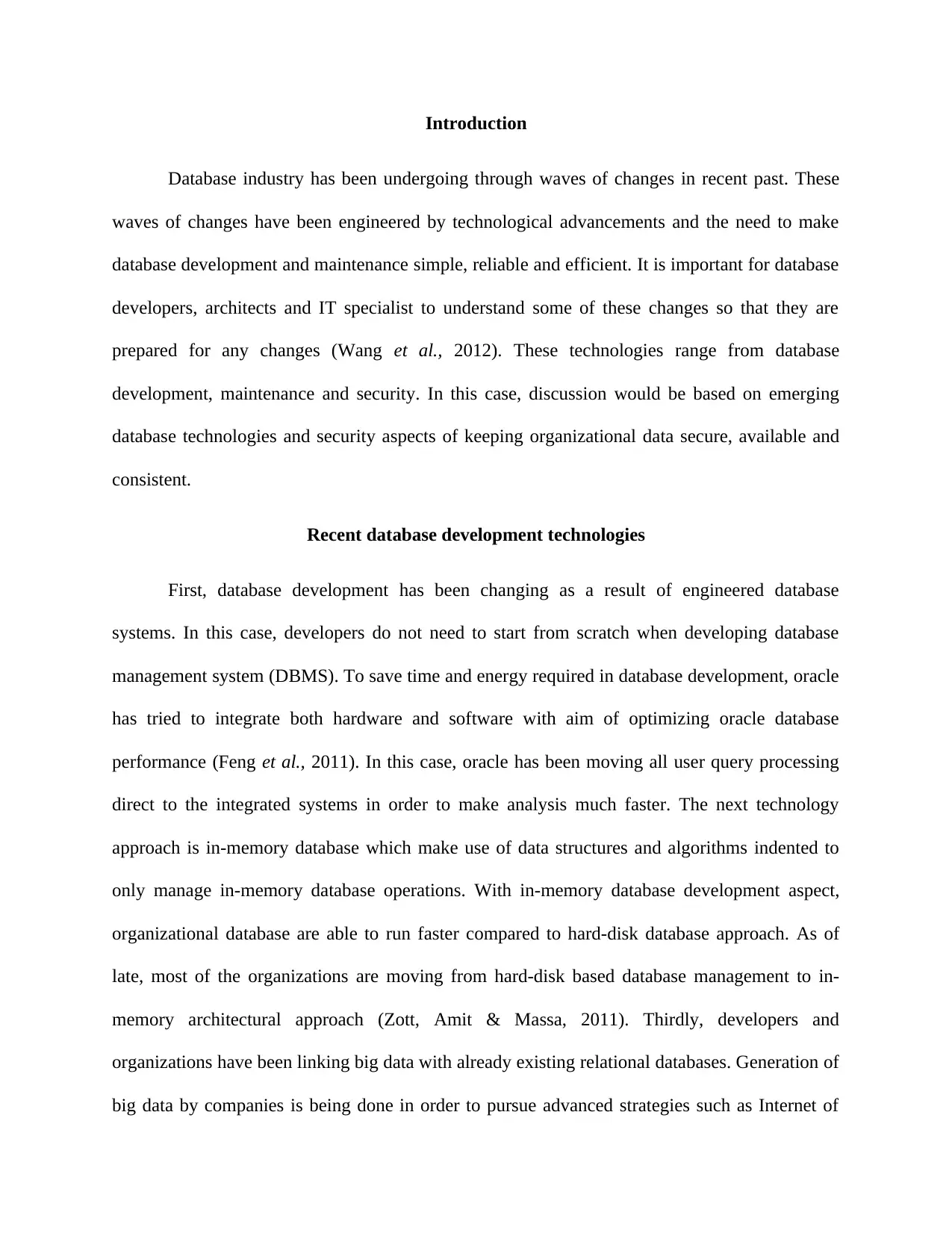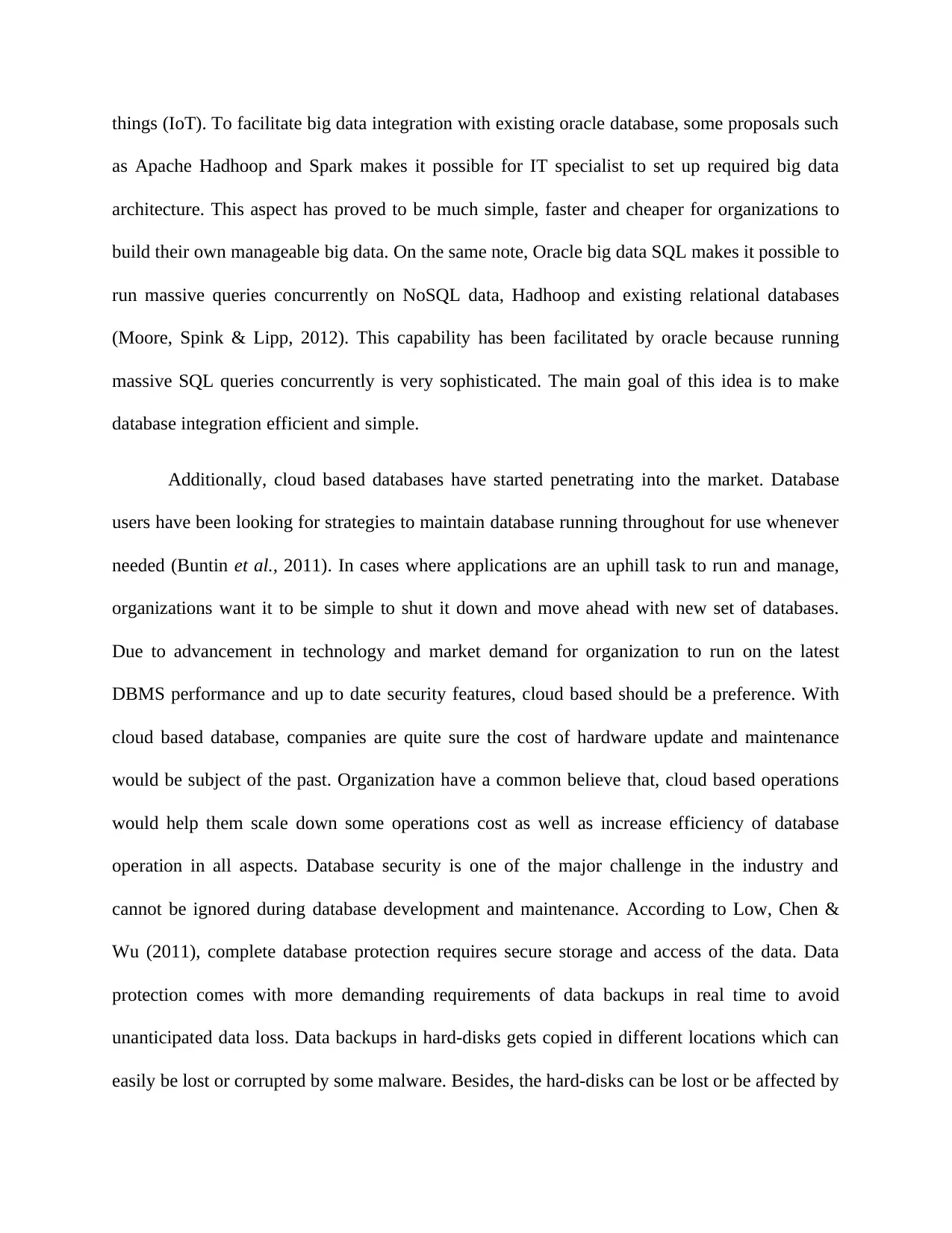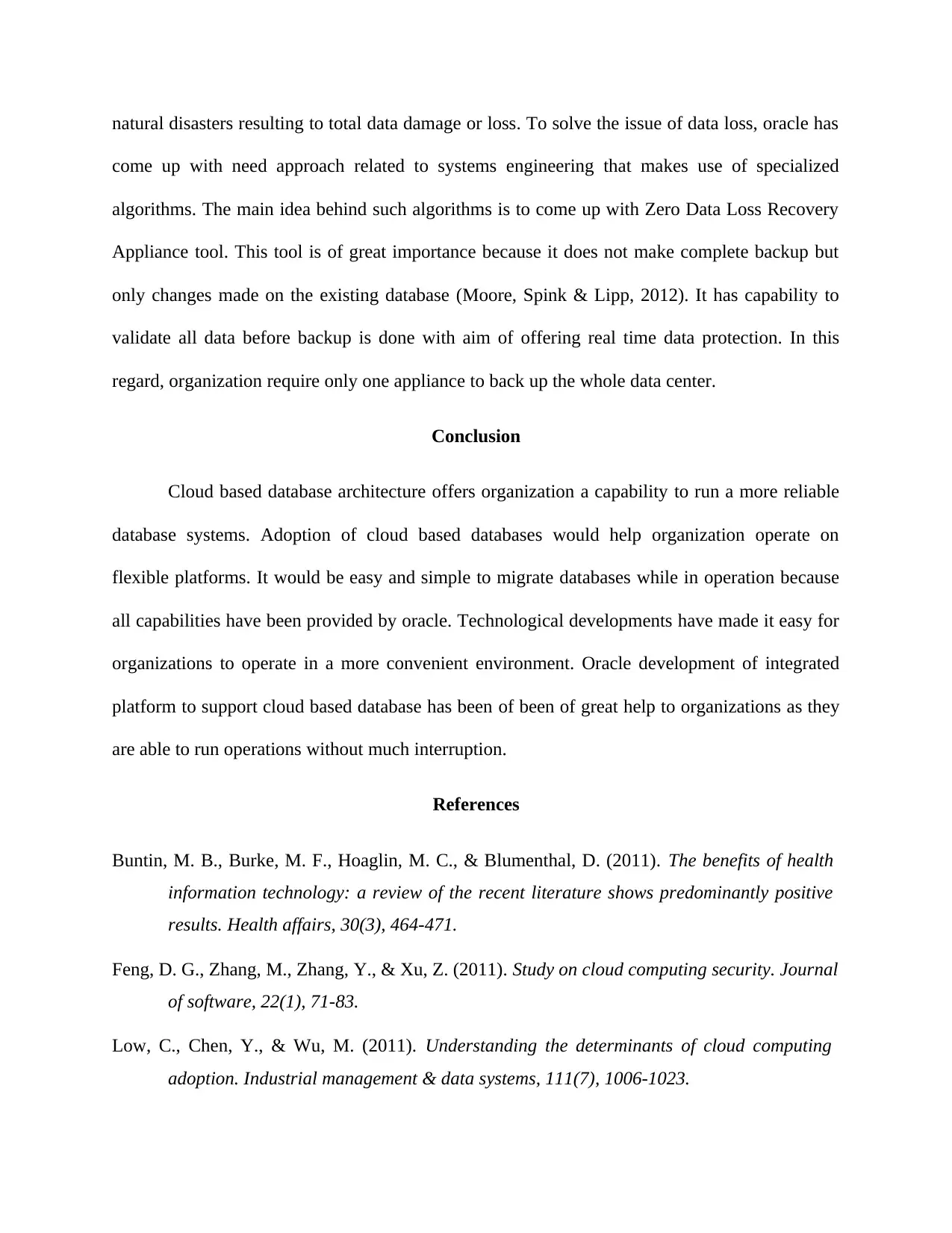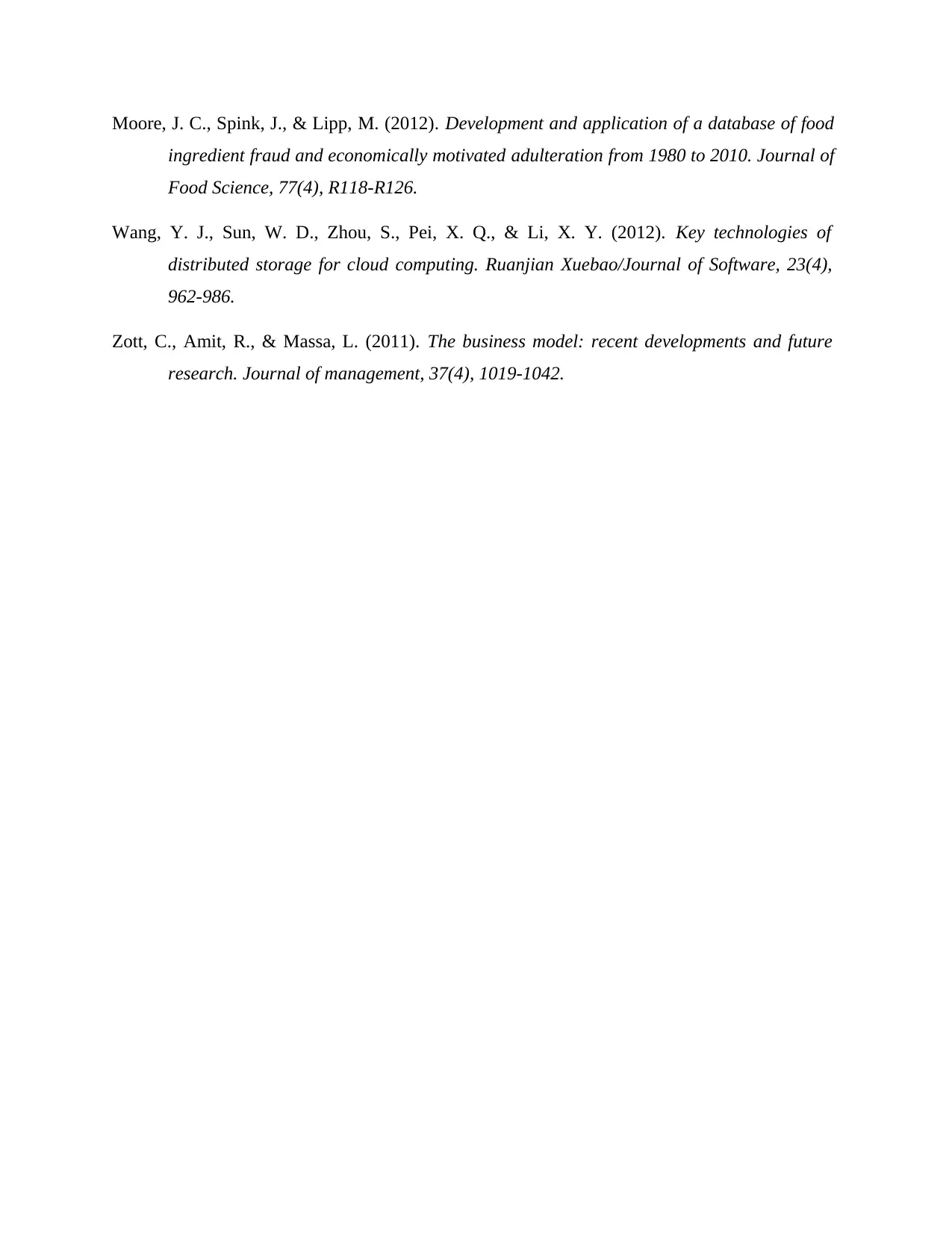Report on Emerging Database Technologies and Security in the Industry
VerifiedAdded on 2023/06/07
|5
|1176
|396
Report
AI Summary
This report provides an overview of recent advancements in database technologies and their security implications. It discusses the evolution of database development, highlighting engineered database systems, in-memory databases, big data integration, and cloud-based databases. The report emphasizes the importance of database security, addressing data protection measures and the use of specialized algorithms like Zero Data Loss Recovery Appliance tools to prevent data loss. The conclusion underscores the benefits of cloud-based database architecture, including flexibility, ease of migration, and the ability to operate in a convenient environment. The report references various studies and research papers to support its analysis of the current trends and future directions in the database industry.

Database developments
Name
Institution
Professor
Course
Date
Name
Institution
Professor
Course
Date
Paraphrase This Document
Need a fresh take? Get an instant paraphrase of this document with our AI Paraphraser

Introduction
Database industry has been undergoing through waves of changes in recent past. These
waves of changes have been engineered by technological advancements and the need to make
database development and maintenance simple, reliable and efficient. It is important for database
developers, architects and IT specialist to understand some of these changes so that they are
prepared for any changes (Wang et al., 2012). These technologies range from database
development, maintenance and security. In this case, discussion would be based on emerging
database technologies and security aspects of keeping organizational data secure, available and
consistent.
Recent database development technologies
First, database development has been changing as a result of engineered database
systems. In this case, developers do not need to start from scratch when developing database
management system (DBMS). To save time and energy required in database development, oracle
has tried to integrate both hardware and software with aim of optimizing oracle database
performance (Feng et al., 2011). In this case, oracle has been moving all user query processing
direct to the integrated systems in order to make analysis much faster. The next technology
approach is in-memory database which make use of data structures and algorithms indented to
only manage in-memory database operations. With in-memory database development aspect,
organizational database are able to run faster compared to hard-disk database approach. As of
late, most of the organizations are moving from hard-disk based database management to in-
memory architectural approach (Zott, Amit & Massa, 2011). Thirdly, developers and
organizations have been linking big data with already existing relational databases. Generation of
big data by companies is being done in order to pursue advanced strategies such as Internet of
Database industry has been undergoing through waves of changes in recent past. These
waves of changes have been engineered by technological advancements and the need to make
database development and maintenance simple, reliable and efficient. It is important for database
developers, architects and IT specialist to understand some of these changes so that they are
prepared for any changes (Wang et al., 2012). These technologies range from database
development, maintenance and security. In this case, discussion would be based on emerging
database technologies and security aspects of keeping organizational data secure, available and
consistent.
Recent database development technologies
First, database development has been changing as a result of engineered database
systems. In this case, developers do not need to start from scratch when developing database
management system (DBMS). To save time and energy required in database development, oracle
has tried to integrate both hardware and software with aim of optimizing oracle database
performance (Feng et al., 2011). In this case, oracle has been moving all user query processing
direct to the integrated systems in order to make analysis much faster. The next technology
approach is in-memory database which make use of data structures and algorithms indented to
only manage in-memory database operations. With in-memory database development aspect,
organizational database are able to run faster compared to hard-disk database approach. As of
late, most of the organizations are moving from hard-disk based database management to in-
memory architectural approach (Zott, Amit & Massa, 2011). Thirdly, developers and
organizations have been linking big data with already existing relational databases. Generation of
big data by companies is being done in order to pursue advanced strategies such as Internet of

things (IoT). To facilitate big data integration with existing oracle database, some proposals such
as Apache Hadhoop and Spark makes it possible for IT specialist to set up required big data
architecture. This aspect has proved to be much simple, faster and cheaper for organizations to
build their own manageable big data. On the same note, Oracle big data SQL makes it possible to
run massive queries concurrently on NoSQL data, Hadhoop and existing relational databases
(Moore, Spink & Lipp, 2012). This capability has been facilitated by oracle because running
massive SQL queries concurrently is very sophisticated. The main goal of this idea is to make
database integration efficient and simple.
Additionally, cloud based databases have started penetrating into the market. Database
users have been looking for strategies to maintain database running throughout for use whenever
needed (Buntin et al., 2011). In cases where applications are an uphill task to run and manage,
organizations want it to be simple to shut it down and move ahead with new set of databases.
Due to advancement in technology and market demand for organization to run on the latest
DBMS performance and up to date security features, cloud based should be a preference. With
cloud based database, companies are quite sure the cost of hardware update and maintenance
would be subject of the past. Organization have a common believe that, cloud based operations
would help them scale down some operations cost as well as increase efficiency of database
operation in all aspects. Database security is one of the major challenge in the industry and
cannot be ignored during database development and maintenance. According to Low, Chen &
Wu (2011), complete database protection requires secure storage and access of the data. Data
protection comes with more demanding requirements of data backups in real time to avoid
unanticipated data loss. Data backups in hard-disks gets copied in different locations which can
easily be lost or corrupted by some malware. Besides, the hard-disks can be lost or be affected by
as Apache Hadhoop and Spark makes it possible for IT specialist to set up required big data
architecture. This aspect has proved to be much simple, faster and cheaper for organizations to
build their own manageable big data. On the same note, Oracle big data SQL makes it possible to
run massive queries concurrently on NoSQL data, Hadhoop and existing relational databases
(Moore, Spink & Lipp, 2012). This capability has been facilitated by oracle because running
massive SQL queries concurrently is very sophisticated. The main goal of this idea is to make
database integration efficient and simple.
Additionally, cloud based databases have started penetrating into the market. Database
users have been looking for strategies to maintain database running throughout for use whenever
needed (Buntin et al., 2011). In cases where applications are an uphill task to run and manage,
organizations want it to be simple to shut it down and move ahead with new set of databases.
Due to advancement in technology and market demand for organization to run on the latest
DBMS performance and up to date security features, cloud based should be a preference. With
cloud based database, companies are quite sure the cost of hardware update and maintenance
would be subject of the past. Organization have a common believe that, cloud based operations
would help them scale down some operations cost as well as increase efficiency of database
operation in all aspects. Database security is one of the major challenge in the industry and
cannot be ignored during database development and maintenance. According to Low, Chen &
Wu (2011), complete database protection requires secure storage and access of the data. Data
protection comes with more demanding requirements of data backups in real time to avoid
unanticipated data loss. Data backups in hard-disks gets copied in different locations which can
easily be lost or corrupted by some malware. Besides, the hard-disks can be lost or be affected by
⊘ This is a preview!⊘
Do you want full access?
Subscribe today to unlock all pages.

Trusted by 1+ million students worldwide

natural disasters resulting to total data damage or loss. To solve the issue of data loss, oracle has
come up with need approach related to systems engineering that makes use of specialized
algorithms. The main idea behind such algorithms is to come up with Zero Data Loss Recovery
Appliance tool. This tool is of great importance because it does not make complete backup but
only changes made on the existing database (Moore, Spink & Lipp, 2012). It has capability to
validate all data before backup is done with aim of offering real time data protection. In this
regard, organization require only one appliance to back up the whole data center.
Conclusion
Cloud based database architecture offers organization a capability to run a more reliable
database systems. Adoption of cloud based databases would help organization operate on
flexible platforms. It would be easy and simple to migrate databases while in operation because
all capabilities have been provided by oracle. Technological developments have made it easy for
organizations to operate in a more convenient environment. Oracle development of integrated
platform to support cloud based database has been of been of great help to organizations as they
are able to run operations without much interruption.
References
Buntin, M. B., Burke, M. F., Hoaglin, M. C., & Blumenthal, D. (2011). The benefits of health
information technology: a review of the recent literature shows predominantly positive
results. Health affairs, 30(3), 464-471.
Feng, D. G., Zhang, M., Zhang, Y., & Xu, Z. (2011). Study on cloud computing security. Journal
of software, 22(1), 71-83.
Low, C., Chen, Y., & Wu, M. (2011). Understanding the determinants of cloud computing
adoption. Industrial management & data systems, 111(7), 1006-1023.
come up with need approach related to systems engineering that makes use of specialized
algorithms. The main idea behind such algorithms is to come up with Zero Data Loss Recovery
Appliance tool. This tool is of great importance because it does not make complete backup but
only changes made on the existing database (Moore, Spink & Lipp, 2012). It has capability to
validate all data before backup is done with aim of offering real time data protection. In this
regard, organization require only one appliance to back up the whole data center.
Conclusion
Cloud based database architecture offers organization a capability to run a more reliable
database systems. Adoption of cloud based databases would help organization operate on
flexible platforms. It would be easy and simple to migrate databases while in operation because
all capabilities have been provided by oracle. Technological developments have made it easy for
organizations to operate in a more convenient environment. Oracle development of integrated
platform to support cloud based database has been of been of great help to organizations as they
are able to run operations without much interruption.
References
Buntin, M. B., Burke, M. F., Hoaglin, M. C., & Blumenthal, D. (2011). The benefits of health
information technology: a review of the recent literature shows predominantly positive
results. Health affairs, 30(3), 464-471.
Feng, D. G., Zhang, M., Zhang, Y., & Xu, Z. (2011). Study on cloud computing security. Journal
of software, 22(1), 71-83.
Low, C., Chen, Y., & Wu, M. (2011). Understanding the determinants of cloud computing
adoption. Industrial management & data systems, 111(7), 1006-1023.
Paraphrase This Document
Need a fresh take? Get an instant paraphrase of this document with our AI Paraphraser

Moore, J. C., Spink, J., & Lipp, M. (2012). Development and application of a database of food
ingredient fraud and economically motivated adulteration from 1980 to 2010. Journal of
Food Science, 77(4), R118-R126.
Wang, Y. J., Sun, W. D., Zhou, S., Pei, X. Q., & Li, X. Y. (2012). Key technologies of
distributed storage for cloud computing. Ruanjian Xuebao/Journal of Software, 23(4),
962-986.
Zott, C., Amit, R., & Massa, L. (2011). The business model: recent developments and future
research. Journal of management, 37(4), 1019-1042.
ingredient fraud and economically motivated adulteration from 1980 to 2010. Journal of
Food Science, 77(4), R118-R126.
Wang, Y. J., Sun, W. D., Zhou, S., Pei, X. Q., & Li, X. Y. (2012). Key technologies of
distributed storage for cloud computing. Ruanjian Xuebao/Journal of Software, 23(4),
962-986.
Zott, C., Amit, R., & Massa, L. (2011). The business model: recent developments and future
research. Journal of management, 37(4), 1019-1042.
1 out of 5
Related Documents
Your All-in-One AI-Powered Toolkit for Academic Success.
+13062052269
info@desklib.com
Available 24*7 on WhatsApp / Email
![[object Object]](/_next/static/media/star-bottom.7253800d.svg)
Unlock your academic potential
Copyright © 2020–2025 A2Z Services. All Rights Reserved. Developed and managed by ZUCOL.





